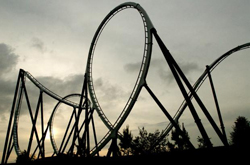A ride built on Coney Island in 1895 took roller coasters to a whole new level; its twists and turns were so extreme that they knocked riders out. Literally.

The Flip-Flap Railway, as it was called, reached 12 times the force of gravity at the bottom of its loops, enough to make most people pass out. Engineers ripped apart the roller-coaster design and found the root of the problem: a neglected math principle. Read more about the equation roller-coaster designers now use to make sure amusement park goers remain conscious.